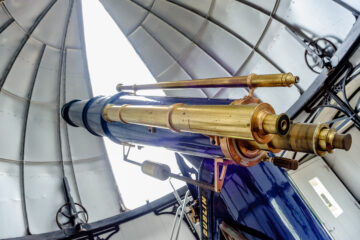By Galin Borisov (not the interstellar comet discoverer)
During this tough period of COVID-19 pandemic, most of the astronomical observatories around the world are closed and no observations are carried out. But my Bulgarian colleague, Yanko Nikolov, decided to self-isolate in the mountain and fulfil the observations with the 2m telescope of the Bulgarian National Astronomical Observatory at Rozhen with remote support by the observer. We, as professional astronomers, are used to doing observations in this way and in particular the so-called Designated Visitor Mode, which can be used with the Very Large Telescope operated by the European Southern Observatory in Chile.
On the night of 15 April, I was the first one to test if we could work like that at Rozhen Observatory. Even though the night was not good for high-quality astronomical observations we decided to give it a go and to make some test. The idea was that Yanko would operate the telescope from the control room in the dome and to change what needs to be changed by hand on the instrument, and me, using remote access by TeamViewer from Armagh, to operate the CCD cameras of the instrument, which are produced by ANDOR company based in Northern Ireland and partially funded by Armagh Observatory with the support of the NI Department for Communities, and carry out the observations. So, the test went pretty well and we were ready for observations during the next days if the weather cooperates.
The forecast for the next three nights was good and seems like that our Northern Macedonian colleague Gordana Apostolovska will be the first lucky observer at the 2m telescope during the pandemic. But as we know there is no free lunch, so we ask her to donate a few hours of observing time to our projects.

One of the projects that we decided to work on with Yanko was polarimetry of the comet C/2019 Y4 (ATLAS) or what was left of it. As you may know, this comet was expected to become much brighter, around 0 magnitudes, i.e. visible to the naked eye (see earlier post on this blog), but on April 6, 2020, astronomers reported its possible disintegration. So we decided to perform polarimetric observations of the comet in order to obtain some more information about the dust that is surrounding the newly formed sub-nuclei. Comets were described for the first time by Dr Fred Whipple in 1950 as “dirty snowballs” made of dust and frozen molecular gases. The dust particles are divided into three main types by their composition: rock-forming elements, Mg, Si, Ca, Fe; the light elements H, C, N, O, the “CHON” particles; and mixtures containing both the rock and CHON elements. Their sizes vary from sub-micron to centimetre.
We chose this project because of two reasons. Firstly, Rozhen Observatory with the FoReRo2 instrument is one of the few places that carry out polarimetric observations. Recently, it was upgraded with a retarder half-wave plate funded by Armagh Observatory with the support of the NI Department for Communities. Secondly, Armagh Observatory itself is a place where astronomers specialising in polarimetry are based. Maybe some of you are wondering what polarimetry, that was mentioned above, means. It is e technique to measure the polarisation of the light, which is … OK, let’s start with some basic facts.
Light, or electromagnetic radiation in general, has three properties: brightness, spectral distribution or colour and polarisation. We, as living creatures or human beings in our everyday life can use mainly the first two, but not polarisation. On the other hand, almost all insects can detect also polarisation and use it for orientation and finding their way in space. The polarisation technique was used for the first time in observational astronomy by François Arago, who was the first to perform a polarimetric observation of a comet when he discovered polarised light from the tail of the Great Comet of 1819. Regular polarimetric observations began in 1908 when G. E. Hale started doing polarimetric observations of sunspots. So until then, astronomers were investigating only two of the three properties of the light, which means that its characteristics were not fully determined. In the case of comets, polarisation can give us information on mineralogy, size and orientation in space of the cometary dust particles at the same time.
FoReRo2 is attached to the 2m telescope and can measure the polarisation of reflected sunlight from cometary dust, therefore we decided to perform exactly these observations and to learn more about the fresh dust released after the recent disintegration of the nucleus of comet ATLAS. We are still analysing the data, but here is one of the raw images, which shows the sub-nuclei of the comet and the dust around them. The distance between the two brightest sub-nuclei at the time of observations was already 3250 km. The images are actually two one above the other, as the technique to measure polarisation is by using the so-called Wollaston prism, which is nothing else but expensive polished calcite, which separates the incident light into two separate linearly polarised outgoing beams with orthogonal polarisation and this is how we measure the polarisation of the reflected sunlight from the cometary dust. The short trails in the image are actually stars, because the comet is moving among them and as we follow it the stars smear into trails.




0 Comments